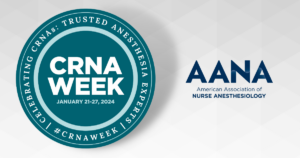As Certified Registered Nurse Anesthetists (CRNA) Week comes to a close, nurses interested in this career or already working as a CRNA are celebrated for the work they do and the dedication to their patients.
As the primary professional organization for CRNAs, the American Association of Nurse Anesthesiology (AANA) sponsors the annual CRNA Week and supports nurses in this specialty. Nurses who decide on a CRNA path know that it is one that requires years of preparation and education, but that offers a distinctive career. 
According to AANA, more than 61,000 CRNAs practice or study in the United States. Their professional specialty requires precise administration of all areas of anesthesiology so they meet with patients before procedures that require anesthesia, monitor them closely while they are sedated, and provide care as they are emerging from anesthesia. They have a patient’s safety as a top priority and must learn to work within the uncertainty of how each patient’s physical state can change their anesthesia reaction.
CRNAs develop a rapport with their patients in a short time. They often meet with patients who are anxious about a procedure and not feeling their best. In a short time, they evaluate the patient while gathering background medical information from the patient and the medical team. They perform an in-the-moment physical assessment that could flag any potential difficulties with anesthesia. This multi-pronged approach requires years of practical nursing experience and the critical thinking skills that can help a CRNA spot and react to any issues.
In many areas, CRNAs provide the anesthesia care available to all residents of a region, particularly the more remote or rural areas. With this option, CRNAs make available a level of care that would otherwise require long travel distances or would remain out of reach. According to AANA, they are also the primary anesthesia providers in the military, especially for hard-to-access field locations, military ships, or other transport modes.
As a CRNA, nurses are able to work in many different locations where anesthesia is used, so the career options are varied and plentiful. In nearly half of the states and all military bases, CRNAs are given full practice authority and they can practice without the supervision of a physician. This designation is given after years of academic work and nursing experience.
CRNAs have a distinct path to achieve the credential. To become a CRNA, nurses first earn a BSN before completing several years of training in a critical care environment. With that combination of school and hands-on nursing work, the next step is to enter a certified nurse anesthesiology program (according to the National Board of Certification and Recertification for Nurse Anesthetists (NBCRNA), there are 130 such programs in the United States). Finally, passing a CRNA certification exam is required after finishing a program.
Once in practice, CRNAs need to remain current in the field with certification that is renewed every four years and also pass required periodic retesting. The result is a career that pays highly (the U.S. Bureau of Labor Statistics states a $189,000 mean salary for a CRNA in 2020) and is in demand as more procedures are being offered that require anesthesia. According to the BLS, CRNAs can expect to see 38 percent growth in the next eight years along with nurse midwives and nurse practitioners.
CRNAs are dedicated to a fast-paced career in which lifelong learning is an expectation. They are as intrigued by the science as they are by the human connections and must be able to adapt to, and react with precision and accuracy to, situations that change rapidly.
- Is the FNP Program Right for You? - April 24, 2024
- WOC Nurses Week Highlights Specialty - April 16, 2024
- Honoring Radiology Nurses Day on April 12 - April 12, 2024


